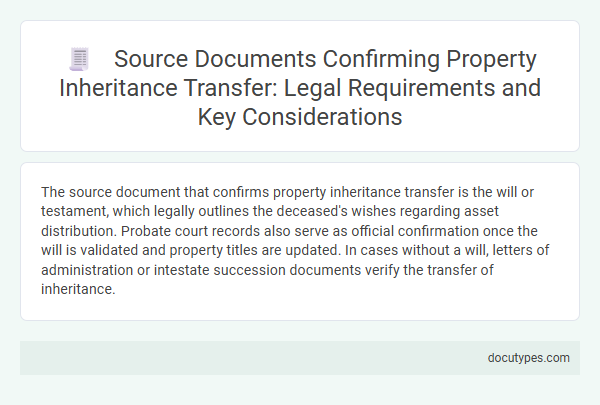The source document that confirms property inheritance transfer is the will or testament, which legally outlines the deceased's wishes regarding asset distribution. Probate court records also serve as official confirmation once the will is validated and property titles are updated. In cases without a will, letters of administration or intestate succession documents verify the transfer of inheritance.
Overview of Property Inheritance Transfers
| Overview of Property Inheritance Transfers | |
|---|---|
| Definition | Property inheritance transfer is the legal process by which ownership of real estate, land, or assets passes from a deceased individual to their heirs or beneficiaries. |
| Key Source Document | The primary source document that confirms property inheritance transfer is the probate deed or inheritance deed, issued after the probate court validates a will or intestate succession. |
| Legal Validation | Transfer of property ownership requires confirmation from the probate court or relevant authority, which ensures the transfer aligns with the deceased's will or local inheritance laws. |
| Important Documents | Key documents include the last will and testament, death certificate, probate order, and the property title deed reflecting the new ownership. |
| Role of Probate Court | The probate court confirms the authenticity of the will and authorizes the property transfer, serving as the primary legal evidence for the inheritance process. |
| Your Responsibility | You may need to initiate probate proceedings and submit source documents to confirm and legally record the transfer of inherited property. |
Legal Definition of Source Documents
A source document confirming property inheritance transfer is a legal paper that provides official proof of the change in ownership. Common examples include a will, probate court order, or inheritance certificate issued by relevant authorities. These documents establish the legal basis for transferring property rights from the deceased to the rightful heirs.
Mandatory Source Documents for Property Inheritance
The mandatory source document confirming property inheritance transfer is the Death Certificate of the deceased. This official document initiates the legal process for transferring ownership rights to the heirs.
The Last Will and Testament or a Grant of Probate is required to validate the deceased's intentions regarding property distribution. In the absence of a will, a Letters of Administration document must be obtained to confirm rightful heirs and authorize the transfer.
Validity Criteria for Inheritance Documentation
The source document that confirms property inheritance transfer is typically the probate court order or a valid inheritance certificate. Validity criteria for inheritance documentation ensure the legal recognition of the transfer and protection of your property rights.
Proper documentation must include verified signatures, official notarization, and compliance with local inheritance laws to be valid.
- Probate Court Order - This legal document officially authorizes the distribution of the deceased's property to heirs based on the will or state law.
- Inheritance Certificate - Issued by the relevant authority, this certificate confirms the rightful heirs and the transfer of ownership rights.
- Legal Compliance - Documentation must meet jurisdiction-specific requirements such as notarization, attestation, and registration to be considered valid for property transfer.
Role of Wills in Property Transfers
The primary source document that confirms property inheritance transfer is the last will and testament of the deceased. This legal document clearly outlines the distribution of property among heirs according to the wishes of the testator.
The role of wills in property transfers is crucial as they provide legal evidence of ownership changes after death. Wills specify who inherits real estate, personal property, and other assets, ensuring a smooth and transparent transfer process. Without a valid will, property distribution usually follows state intestacy laws, which may not reflect the deceased's preferences.
Importance of Probate Court Orders
Probate court orders serve as the primary source document confirming the transfer of inherited property. These legal documents officially validate the rightful heirs and authorize the distribution of the deceased's assets.
- Legal Authority - Probate court orders provide legally binding confirmation that property inheritance transfers are valid and enforceable.
- Heir Verification - They establish the identity of rightful heirs, ensuring property is distributed according to the deceased's will or state law.
- Title Transfer - The orders facilitate the formal transfer of property titles, preventing disputes and clarifying ownership.
Without probate court orders, property inheritance transfers lack legal recognition and may face challenges in ownership claims.
Succession Certificates and Their Uses
A succession certificate serves as a vital source document confirming the transfer of property inheritance, especially in cases where the deceased's assets do not include immovable property. It legally authorizes the heirs to claim debts and securities left by the deceased.
Succession certificates are primarily issued by a civil court after verifying the rightful heirs, ensuring a smooth transfer of financial assets. This document simplifies the legal process, protecting against unauthorized claims on the inherited property.
Essential Tax Documents for Inherited Property
What source document confirms property inheritance transfer? The primary document used to confirm the transfer of inherited property is the death certificate of the deceased owner. Alongside this, the will or probate court order serves as essential tax documents required to process the inheritance legally and for tax purposes.
Common Challenges in Document Verification
Source documents that confirm property inheritance transfer typically include the will, probate court orders, and the death certificate. Common challenges in document verification arise from forged wills, missing probate records, and discrepancies in legal descriptions. You must carefully authenticate these documents to ensure a smooth and legitimate property transfer process.
What Source Document Confirms Property Inheritance Transfer? Infographic

